COVID-19 in Canada: 'Big parties are off' this holiday season, Ontario eyes loosening some restrictions
For more on today’s top stories and the spread of the novel coronavirus across the country, please refer to our live updates below throughout the day, as well as our COVID-19 news hub.

Newly released short-term COVID-19 forecasting shows that by Nov. 8, Canada could see between 10,285 and 10,400 deaths, and between 251,800 and 262,000 cases.

When looking at how the epidemic may evolve in Canada over the next month, the key message from Dr. Theresa Tam, Canada’s chief public health officer, is that Canadians need to limit their contacts.
“If we increase or if we even maintain our current rate of contact with others, the epidemic in Canada is forecasted to continue increasing steeply,” Dr. Tam said. “To bend the epidemic curve and reduce transmission to lower levels...we must really reduce our number of contacts as much as possible.”
She indicated that this includes limiting everyday contacts to our households, as much as possible, maintaining physical distancing, good hygiene practices and in areas where the infection rate is high, restrictions and closures may be needed for a period of time to slow the spread of the virus.
“We held our lead on COVID-19 for some time but since resuming more activities over the summer and perhaps slipping on a few of our key dance steps — consistent physical distancing, exemplary hygiene and mask wearing — some of us have lost our lead,” Dr. Tam said. “I know Canadians can dance and take back the lead again.”
“This virus will cut in anywhere and at anytime we let it. So let’s get back in the dance and take the lead.”
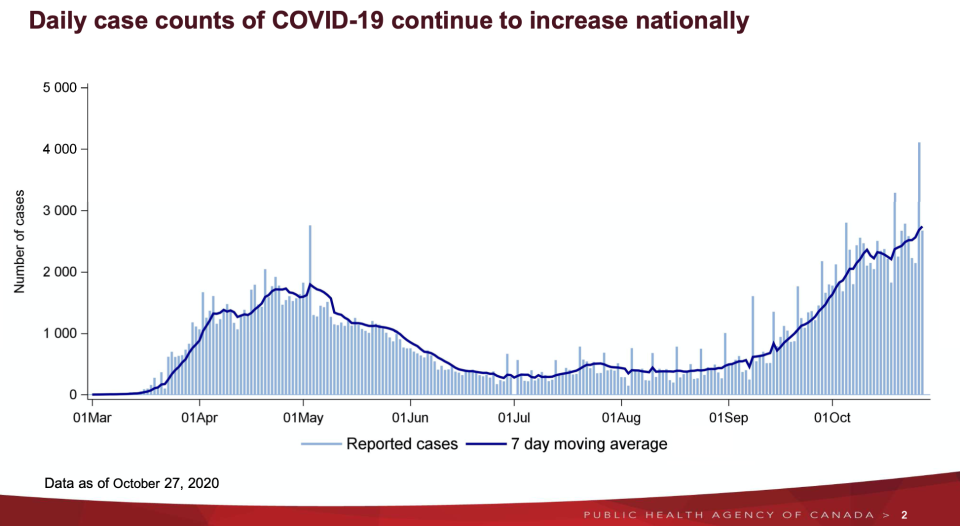
Canada’s COVID-19 cases remain above “peak levels” in the first wave in the spring, with an average of almost 2,800 cases reported daily in the past week. Ontario and Quebec significantly impact the national curve with over 75 per cent of all cases in Canada since the beginning of the pandemic.
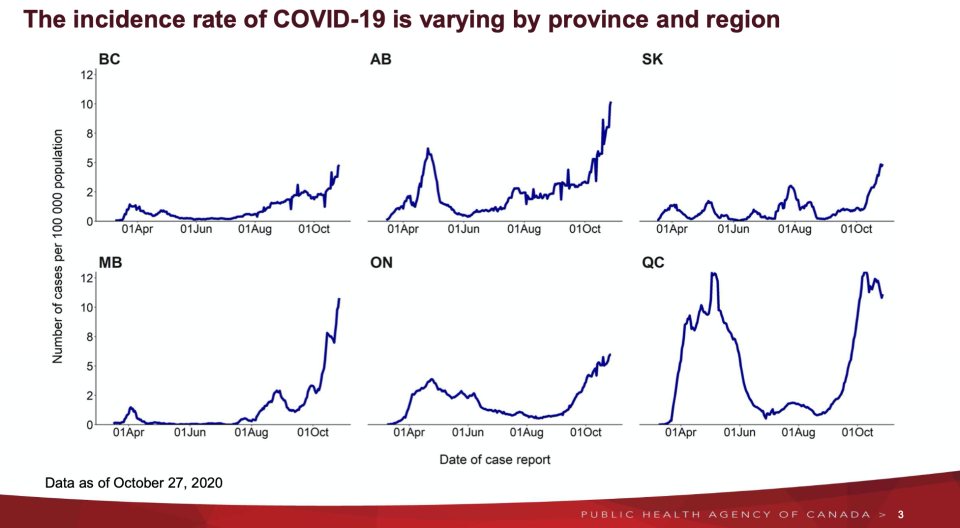
“The growth in Quebec case counts has appeared to gradually stabilize but still averaging around 1,000 cases daily during recent weeks,” Dr. Tam highlighted. “At the same time, over the past two weeks, British Columbia, the Prairie provinces and Ontario have all marked their highest daily case counts since the beginning of the pandemic.”

As of Oct. 8, 19 health regions reported more than 50 cases per 100,000. That number had almost doubled by Oct. 27, with 34 health regions reporting more than 50 cases per 100,000.
Dr. Tam also highlighted that 26 Indigenous communities are now reporting two or more active cases.

Although COVID-19 cases have mostly been seen in Canadians between the ages of 20 to 39 recently, Canada is now seeing a “concerning rise” in incidents among people 80 years of age and older, which are particularly at risk of severe illness and death.
“Increasing incidents in those under 20 years of age reflects participation of children and youth in school, daycare and college,” Dr. Tam explained. “In the almost two months since most schools opened in Canada, approximately 2,100 have reported at least one confirmed case and over 40 schools have reported five or more cases.”
She also identified that COVID-19 infection rates are different across neighbourhoods.
“Factors such as gender, income and race have influenced people’s risks of being infected and becoming severely ill and resulted in disproportionate impact on seniors, people living with disabilities, women, essential workers and racialized populations,” Dr. Tam said. “This is a Canada-wide issue.”
“Not everyone can stay at home and work but we need to support essential workers who are bringing food to our tables, who are working in those grocery stores. All the other supports come in to keep them working safely.”
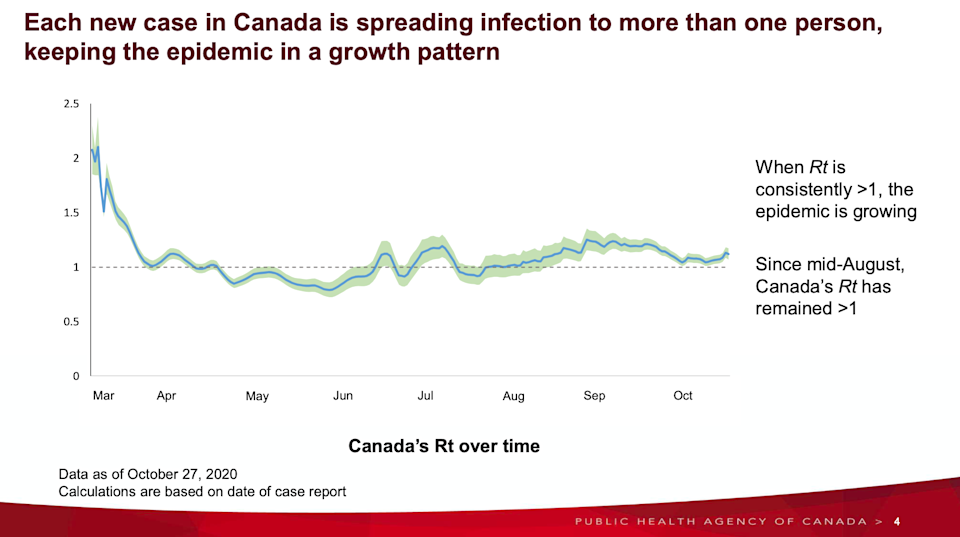
Canada’s chief public health officer reminded the public that the effective reproduction number (Rt) needs to remain below one, but has exceeded that threshold since the end of August.
There is also a “worrying” trend in Canada when the percentage of people testing positive for COVID-19 continues to rise across the country.
The average is approaching four per cent nationally, with “concerning spikes” in test positivity rate in some provinces, Dr. Tam warned.
Canada’s chief public health officer also highlighted that the pattern of outbreaks has been “shifting,” with particular concerns about outbreaks in long-term care facilities.
There have been a number of outbreaks in healthcare settings.
“At the same time, an increasing number of outbreaks are being linked to private social gatherings,” Dr. Tam said. “Some of these events are considered super spreader events, when a single event results in a large number of cases.”
“With large numbers of contacts involved, these put significant strain on public health capacity to interrupt transmission through testing and tracing.”
When asked about the upcoming holiday season at the end of the year, Dr. Tam had a clear, although likely upsetting message: “Big parties are off” while Canada and international communities work to discover and distribute an effective COVID-19 vaccine.
“People need to keep their contacts...as small as possible,” she said.
Ontario may decide to loosen restrictions next week
Ontario Premier Doug Ford said he has asked provincial public health officials to develop a plan to loosen modified Stage 2 restrictions, expected to be presented next week. This follows modelling data revealed Thursday that shows a “slowing” of the rate of growth.
“I truly believe if we didn’t make this decision we would be having a different conversation today,” Ford said. “We’d be having a conversation possibly like France or like Spain.”
“It was the right decision...We let our guard down.”
Dr. Barbara Yaffe, Ontario's associate chief medical officer of health, stressed that there is still “significant community spread” in the province.
“We look at what happened before we implemented the modified Stage 2,” Dr. Yaffe explained. “Something like 30 to 40 per cent of outbreaks, particular in Toronto and in Ottawa, were in restaurants or gyms.”
“What you saw yesterday was a combination of the data for the last two months and things have gotten better in those settings, which is great. Those settings are places where people can congregate inside, for significant periods of time, they may be somewhat crowded and if they’re eating they take their masks off, if they’re exercising they tend not to wear a mask and they may be breathing heavily.”
She stressed that the province is trying to “balance the risks and benefits” of each measure.
The premier added that these restrictions “can’t go on indefinitely” and the healthcare system and economy work hand-in-hand with each other.
Manitoba adds restrictions across the province, primarily in Winnipeg
As the number of COVID-19 cases in Manitoba continues to rise, the province is moving the Winnipeg region into critical level (red) of response and the rest of the province is in the restricted level (orange).
“We’ve seen certainly a lot more cases than what we wanted to,” Dr. Brent Roussin, Manitoba’s chief medical officer of health said. “There’s no surprise with this virus, it’s being transmitted exactly as we think it would, in exactly the manner in which we thought it was.”
“If we look at a lot of the cases, we see people being out and about when they’re ill, we see large gatherings and so we just know that it’s spread that way...We have to get that reset, we have to get things back under control here.”
This comes as the province reported 480 newly confirmed COVID-19 cases but this does include cases across a number of days as Manitoba managed a backlog of tests. Of the cases reported on Friday, two were identified Sunday, four were identified Monday, 44 were identified Tuesday, 193 were identified Wednesday and 237 were identified Thursday.
Effective Monday, Nov. 2, the Winnipeg Metro Region will have the following restrictions:
Bars and restaurants will be closed except for take-out and delivery
Most retail will be reduced to 25 per cent capacity
Sports and recreation programming will be suspended
Gyms and fitness centres will have reduced capacity to 25 per cent and masks will be mandatory, even when exercising
Movie theatres and concert halls will close
Personal services have no change and stay at 50 per cent capacity
Non-urgent and elective surgeries and diagnostics will be suspended
Faith-based gatherings are reduced to 15 per cent or 100 people, whichever is lower
The province is also “encouraging” businesses in Winnipeg to have staff work from home wherever possible.
The orange level restrictions that will go into effect on Nov. 2 include:
Public and private group gathering sizes limited to five, in addition to household
Capacity limited to 50 per cent at restaurants and bars, with group sizes limited to five
Reduced retail capacity to 50 per cent, encouraging limiting those who go shopping from each household
Blended learning for grades 9 to 12, voluntary blended learning temporarily available for kindergarten to Grade 8, encouraging as much physical distancing as possible
Personal services have no change and stay at 50 per cent capacity
Reduced spectators at sports and recreation facilities to 25 per cent
Gyms and fitness centres require contact information for all attendees and mask use at all times, except when exercising
Faith-based gatherings are reduced to 20 per cent or 250 people, whichever is lower
Visitation at all Manitoba hospitals has also been suspended, with exceptions made for patients receiving end-of-life care, in labour and delivery, and paediatrics.
Lanette Siragusa, Manitoba’s health system integration and quality lead and chief nursing officer for Shared Health, revealed that as of around 8:30 a.m. local time on Monday, ICU capacity was at 96 per cent.
“With these daily case counts increasing we can expects there’s going to be more hospitalizations in the next week or two,” she said.
As of Friday, 99 surgeries have already been cancelled this week due to “COVID-related pressures.”
“The suspension of non-urgent surgical and endoscopy procedures is being done as part of our ongoing efforts to protect the health of patients,” Siragusa said.
CASES AND OUTBREAKS
Ontario premier’s constituency closed after COVID-19 outbreak
A statement from the office of Ontario Premier Doug Ford confirms that his constituency office in Etobicoke North has been closed after COVID-19 cases were detected.
“Toronto Public Health has confirmed cases of COVID-19 among staff members of Premier Ford’s constituency office,” the statement reads. “The Premier has not visited the office in the past two weeks and has had no exposure.”
The Etobicoke office is expected to be closed “for the foreseeable future” to allow for deep cleaning of the space.
“We had a few visitors come in and that’s where they believe they contracted COVID,” Ford said at a press conference on Friday.
This comes as Ontario reported 896 new COVID-19 cases on Friday, including 314 cases in Toronto, 173 in Peel, 115 in York Region and 92 in Ottawa.
The province confirmed nine more COVID-19 deaths, bringing the total to 3,127.
A total of 41,008 tests were completed in the last day, with 41,063 tests under investigation.
There are currently 314 people with COVID-19 in Ontario hospitals, including 75 in ICU.
Across the province, 78 long-term care homes have an active outbreak with 421 active cases in residents and 280 staff cases.
Ontario reported 61 new school-related COVID-19 cases, including 40 student cases, four staff cases and 17 cases that haven’t been identified.
Quebec reports more than 950 new cases, 18 new confirmed deaths
Quebec reported 952 new COVID-19 cases on Friday, including 195 cases in Montreal, 151 in Montérégie and 109 in Lanaudière.
The province also confirmed 18 new deaths with four of them occurring in the last 24 hours.
There are currently 515 people with COVID-19 in Quebec hospital, including 81 people in intensive care.
Yukon reports first COVID-19 death
The Yukon government confirmed the territory’s first COVID-19 death, a person who had underlying medical conditions.
“As we continue our work to contain this current outbreak, I offer assurances that the risk to the community remains low,” a statement from Dr. Brendan Hanley, Yukon’s chief medical officer of health said in a statement. “With this sad news we all need to maintain our efforts to prevent further disability or deaths in Yukon from the pandemic.”
The individual died on Oct. 29 and was isolating at home at the time.
There have been 23 confirmed COVID-19 cases in the Yukon, 17 of which have recovered. There is currently a cluster of cases associated with a recent exposures in Watson Lake.
Check out our COVID-19 in Canada topic page for latest news, tips, health updates, cases and more.



